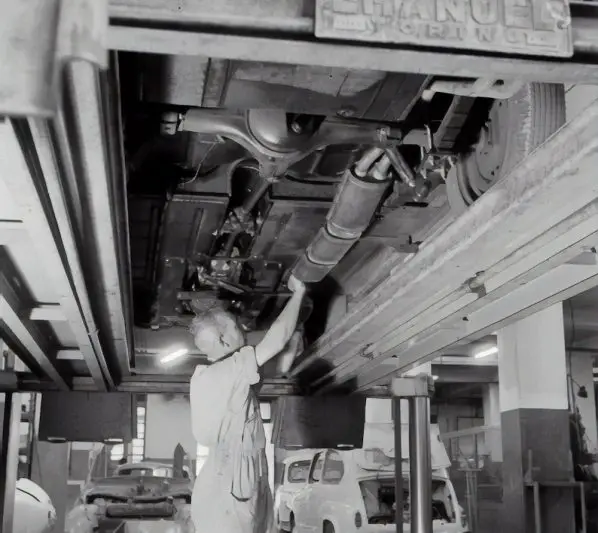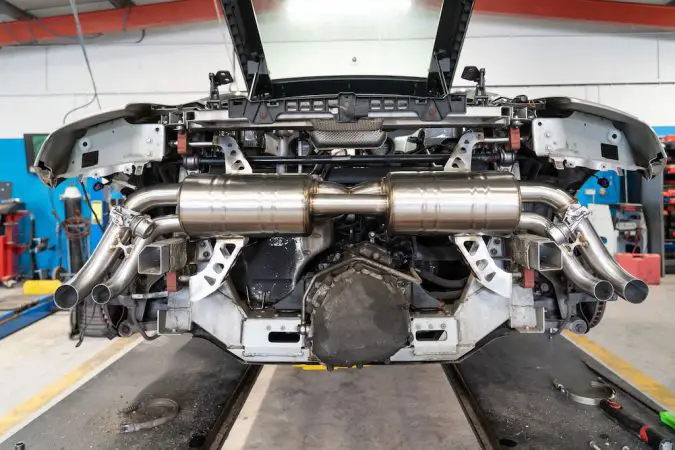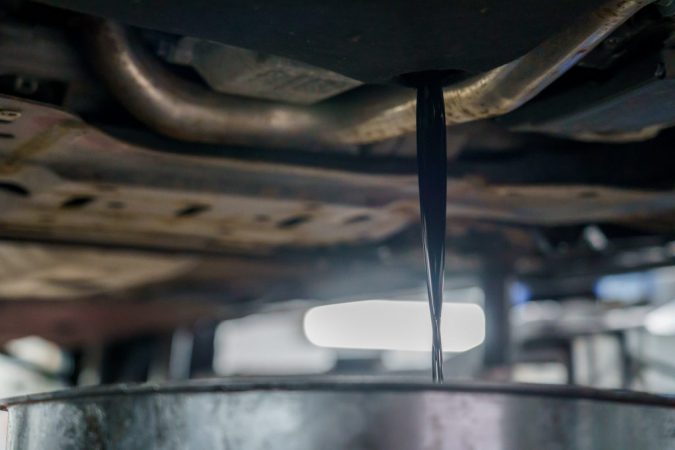When it’s that time of the year again to have your car serviced, the potentials for bank-breaking fixes can be daunting. A particular surprise that you may not have expected in this situation would be the differential fluid change cost. You might be used to oil changes or coolant flushes (and learning how to flush coolant system), but have you never come across a diff oil change before? Besides, what is this magical “differential”, anyway?
Well, if you’re able to turn your car precisely when and where you’d want it to, you can thank the role that the differential plays for this to happen. It’s instrumental in how a vehicle as large as trucks can turn on a dime, as it manages the rotation of each turning wheel. Thus, we can see how a differential fluid change cost might be a necessary expense, given its importance. Here are some reasons why…
What Should You Understand About A Differential And How It Works?
Before we can get into the differential fluid change cost, it might prove helpful for us to understand more of how a differential works. First, let’s look at the problem that it tries to solve. When you’re on the verge of making a turn, the lack of a differential makes it so that both the inner and outer wheels rotate at the same speed. For a mock scenario, let’s say you’re making a left-hand turn in your car.
As you’re moving forward, your left-hand wheels would be the inner wheels – as it’s making contact with the apex, or peak of a corner – and your right-hand wheels would be the outer wheels. Without a differential, this simple turn would be quite difficult. Not only would it be rough and uncomfortable, but there’s more strain on the wheels, and it takes far longer – in distance and time – just to turn.
Turning a vehicle without a differential isn’t ideal, so let’s put one in. In a nutshell, the differential is engineered to rotate the wheels at different speeds. In other words, it provides the proportional RPM on both the inner or outer wheels, so that a rotation of your vehicle can be done effectively. Imagine how your body reacts when you signal that you’d like to turn your person leftwards.
How Does A Differential Help Your Car To Turn?
Your left legs – the inner rotation, so to speak – would slow down or stop. Then, your body rotates to the left, and your right legs make a huge swing and step forward for you to turn. This analogy works the same way on a vehicular differential. If you need to turn left, the differential would send less of the engine’s power – RPM, basically – to the left-hand wheels, so that it could slow down.
In the meantime, it sends a greater proportion of that split engine power to the right-hand wheels, so it could push the car leftwards, thus initiating the turn. To put it simply, a turn in your car can only be effectively done in a short distance of time and space, and without excessive discomfort or resistance on the wheels, if the outer wheels are to travel at higher speeds of rotation than the inner wheels.
In a car, there are three types of differentials. These would be an open differential, limited-slip diff, or based on a torque vectoring set-up. One thing to note is that the differential will always be mounted where power is being sent to. If your car is front-wheel driven, then the differential is placed on the front axles. This is where it needs to manage the power distributed to the wheels.
Should your car be rear-wheel-drive, the differential should be mounted on the rear axles. While the front wheels are responsible for steering, the “diff” would shift its power on the rear wheels where it’s best served. For all-wheel-drive vehicles or 4x4s, you’d have a centrally mounted differential, instead. Here, it can manage the delivery of power, and thus rotation of the wheels, across all four corners.
What Does Your Car’s Differential Fluid Do, And Why Worry Over A Differential Fluid Change Cost?
So far, we’ve been able to sufficiently understand what the differential does in your car. It’s safe to say that it’s among the most crucial components in any vehicle. So then, where does the differential fluid come into play, and why should you have to worry about a differential fluid change cost? This fluid in question is sometimes referred to as “gear oil”, and its job is as the name implies.
Namely, the differential fluid aids in lubricating your differential, and adds some grease to smoothen out the internal components. Most especially, it has to prevent hard-working parts such as the diff’s ring and pinion gear, from grinding each other down. That metal-on-metal contact between it, as well as other inner modules of the differential, is more than enough to cause complete diff failure.
Some of these other units include the differential’s clutch packs, gears, and car bearings. Aside from that, and just as how it works for motor oil, differential fluid also acts as a partial coolant. By reducing as much friction as it can, it’s essentially aiding in cooling down potential heating up and burning out between those moving parts. But unlike motor oil, differential fluid is a much thicker substance.
That’s because it has to work under extremely high pressures, rather than compensate for the higher temperatures of the engine. There are, in fact, two types of differential fluid:
Mineral Oil – Just like conventional motor oil, mineral oil is a naturally obtained differential fluid. It’s essentially a by-product of crude oil refining.
Synthetic Fluid – Where mineral oils are organic, synthetic differential fluid is specially formulated in a lab. Just like synthetic motor oil, synthetic diff fluid has been chemically engineered to be as perfect as it can be, and provide optimal performance.
What Are The Symptoms To Look Out For When Thinking About A Differential Fluid Change Cost?
Before we move on, it’s worth making a mention of this as we shove along in looking at a differential fluid change cost. As we spoke of the types of the differential fluid, there are varying specifications for it, too. A rear-wheel-drive vehicle, as we’ve established, relies exclusively on a rear differential. A front-wheel-drive car, meanwhile, adopts a transaxle design, where it also accommodates the gearbox.
Thus, both drivetrains have different mixes of differential fluid that you should pick accordingly. Rear-wheel-drive vehicles have their own rear differential gear oil. For certain other vehicles, like trucks, could use the same differential fluid for both the rear differential and the inter-axle differential. But in either set-up, how can you know when it’s time to worry about a differential fluid change cost?
Commonly, most cars have an average lifecycle of around 30,000 to 60,000 miles for their respective differential fluid. This is the case, as just like motor oil, differential fluids undergo an intense amount of exposure to heat, friction, and pressure. After a while, all of these combined are sufficient to wear down or burn out the chemical compounds of the fluids, rendering them ineffective at their tasks.
Although, that service interval varies from one manufacturer to another. But what if you haven’t been paying attention… How can you tell when it’s time to get that gear oil changed? Just for you, here are some symptoms to look out for, before even thinking about a differential fluid change cost…
1. Burning Smell Coming From The Differential
If you’re familiar with your car, then you should know where the differential is located. Once you’ve found that one out, try to put your nose close to it, specifically after a drive. Do you smell a burnt or a heaty scent coming from the differential? In that case, your differential is overheating (which is what the “AT oil temp” light in a Subaru aims to tell).
The differential might heat up excessively if the gear oil hasn’t been changed in a long time, and has worn itself out. Or, that differential fluid may have been contaminated, and hence isn’t working as it should. Ordinarily, this contamination might come from moisture or water vapor.
Alternatively, it might also derive from impurities and dirt seeping into the differential housing. If so, the gear oil is now too old or dirty for it to effectively lubricate your differential’s many moving parts. There will be a lot of grinding and contact between these metal units, and failure is imminent.
2. Odd Sounds Heard From The Differential
If you can’t feel the heat, you might be able to hear it. To be precise, you might be able to hear some odd whirring, whining, or howling noises. You’ll especially hear them when turning, as that’s when the differential is working at its peak.
Should you hear these peculiar sounds, it’s a good time to consider a differential fluid change cost. It’s an indication that there’s indeed some metal-on-metal contact between the diff’s gears, clutches, bearings, and so on, as it can’t be efficiently lubricated.
3. Felt Vibrations, Especially When Cornering
Just like the sounds of a bad diff, you might also feel its pain when you’re driving. These vibrations can get more and more intense when you’re hauling at speed, and while cornering, as well. It feels as though something in the car is grinding itself away.
While vibrations are an indicator of many possible faults in a car, worn-out differential fluid is among them. This tells you that the metal components within the diff are contacting each other, and are likely out to wear one another down.
How Much Does A Differential Fluid Change Cost?
It’s time to get into that bitter pill, so how much does a differential fluid change cost? After all, a case of blind ignorance and continue driving your car with its old gear oil is never a good practice. Going for a drive with burnt-out or worn-down differential fluid will do significantly more harm than good. It can wear out the differential, such as through overheating or grinding away at the metal parts.
Not too long later, the differential as a whole might suffer from complete failure. This turns what can otherwise be a simple fluid swap, into a very pricey overhaul. Therefore, be sure to head over to a local mechanic or dealer as soon as you notice any of the aforementioned symptoms, and get that gear oil changed. But how does the differential fluid change cost fare compared to other repairs?
Actually, it’s quite cheap, comparatively speaking. It does differ from one vehicle to another, so your mileage will vary. Usually, a differential will need between 1 to 4 quarts of fluid. In some vehicles that have all-wheel-drive set-ups or for 4x4s off-roaders, they have two distinct differentials. There’s one in the back, and one up in the front. Thus, you’ll have to double that amount of needed fluids.
In either scenario, it doesn’t even take that long for a differential fluid change to be done. It could be easily done within an hour. Overall, this contributes to a fairly cheap differential fluid change cost of around $80 to $140, accounting for the oil and labor. The labor rates should be around $50 to $70, whereas a bottle of differential fluid can be found for around $30 to $70, depending on the brand.
Differential Fluid Change Cost Samples
Actually, and if you’re lucky enough to spring up for a discount, a bottle – usually a quart of gear oil – could be bought for much less than that. Shop around, and you might just get away with an entire quart of differential fluid for around $6 or so. To give you a broader view, however, here’s a slightly more realistic sample of the breakdown for a differential fluid change cost for numerous marques…
- Ford F-Series – Parts: $30-$70/ Labor: $60-$80/ Total: $90-$150
- Chevrolet Silverado – Parts: $30-$70/ Labor: $60-$80/ Total: $90-$150
- Ford Focus – Parts: $30-$70/ Labor: $40-$60/ Total: $70-$130
- Ford Fusion – Parts: $30-$70/ Labor: $40-$60/ Total: $70-$130
- Honda CR-V – Parts: $30-$70/ Labor: $60-$80/ Total: $90-$150
- Honda Civic – Parts: $30-$70/ Labor: $40-$60/ Total: $70-$130
- Toyota Camry – Parts: $30-$70/ Labor: $40-$60/ Total: $70-$130
- Toyota Corolla – Parts: $30-$70/ Labor: $40-$60/ Total: $70-$130
- Nissan Altima – Parts: $30-$70/ Labor: $40-$60/ Total: $70-$130
- Honda Accord – Parts: $30-$70/ Labor: $40-$60/ Total: $70-$130
Can You Save Money On A Differential Fluid Change Cost By DIY-ing It?
Thus far, we’ve understood just how (relatively) cheap a differential fluid change cost is. With that in mind, there aren’t any reasons why you should put off a gear oil change. That’s after seeing just how catastrophic differential failure can be, should you ignore swapping out the fluids. Lighter damages, such as needing to replace the seals and gaskets, aren’t too terribly expensive.
These might set you back around $200 to $400. Nonetheless, and if the damage is more extensive, it can result in substantial internal wear and failure. If so, the entire differential might need to be taken apart, and then overhauled. A repair job like this could leave you hanging with a bill of at least $400 to $800 or more. It’ll be even pricier for front-wheel-drive cars, thanks to its complex transaxle layout.
On the other hand, the benefits of running on the fresh differential fluid are numerous. Your car will run smoother and could go on for longer. With little to no wear on the diff, they can work better, and save you a lot in repairs down the road. It should, therefore, be a no-brainer to consider a differential fluid change cost whenever that time comes around.
But what if you’d like to save even more money from a differential fluid change cost. The lion’s share of the costs, as we’ve sampled earlier, come from labor anyways, not the fluid itself. Well, it turns out that going DIY on a differential fluid change is actually quite simple, and is something that’s quite feasibly for even the rookies to do. If you’re one of them, here’s a little guide to help you out…
Step 1: Get Your Car Jacked Up
As you’ll be accessing the differential, you have to get underneath your car. The first step, thus, will be to jack up your car. Drive it onto a level surface, and find its optimal designated jacking points. You can refer to your owner’s manual to see where it is, and safely jack up your car.
Never, ever work underneath a car that’s supported only by the jack itself, as the jack might lower the car unintentionally by accident. Once your car’s been lifted up, get some jack stands to support its weight. Slowly and surely, position the jack stands on all four corners.
Step 2: Locate The Differential
The differential shouldn’t be hard to find. To put it as simply as possible, it’s that odd hump that goes between the wheels. For front-wheel-drive cars, it should be around the front, and vice versa for rear-wheel-drive. There may be two, three, or more differentials in the case of all-wheel-drive, and 4x4s.
Some vehicles, like the Mercedes G-Class, have a front, center, and rear differential altogether. So, try to spot the differential, and find that basketball or pumpkin-shaped housing. Next up, find the drain bolt, which sits along the bottom of the differential.
Step 3: Drain Out The Old Gear Oil
That drain bolt should be familiar with the drain plug for the motor oil pan. If you’re working on a front-wheel-drive car – the oil pan’s around the front, too – make sure you don’t get this mixed up. Now, place a container at the bottom of the differential to drain the old fluids into.
You could then use a socket wrench to loosen the bolt. Once it’s sufficiently loose, use your hand to gently unscrew it the rest of the way, and apply a bit of pressure inwards, as well. You wouldn’t want the gear oil to start leaking and spraying everywhere just yet.
When the bolt is nearly unthreaded, pull the bolt away, and let the old fluids drain out. On an important note, be certain that your car is left cooled. Don’t try to drain the differential fluid after you’ve gone for a drive, as the gear oil might still be hot enough to burn you.
Step 4: Locate The Differential Fluid Fill Bolt
It’ll take a few minutes for the old gear oil to thoroughly drain out. Let it drain, until there’s barely a trickle left. Once it’s just about done draining, screw the bolt back in again. Once more, thread it for most of the way with your hands, and then tighten the rest with a socket wrench.
Be mindful not to overtighten the bolt. When you’ve finished with that, it’s time to look elsewhere to find the fill bolt. It should be on the opposite end of the drain bolt, and often found near the top of the differential. It may be hard to find it exactly, so it might prove handy to have a manual in hand.
Some cars nowadays place the fill bolt near the rear-end or back of the differential, which makes it easier to access. As we’ve done before, loosen the fill bolt with a socket wrench. Then, use your hand to unthread it the rest of the way.
Step 5: Fill In The New Differential Fluid
Finally, it’s time to add in the fresh gear oil. Granted, it may be a bit hard – if not impossible – to fill in the differential fluid directly. Simply pour it in is hindered by the odd angle and tight clearances surrounding the fill bolt. If you’re in that situation, having a hand pump will be a godsend.
Depending on how the gear oil bottle looks on your end, remove the seal at the top. Then, insert the inlet hose or tube of the hand pump into it. Slowly crank or pump in the new gear oil into your car’s differential. Keep pumping until the recommended amount is reached.
Or, when you start seeing that fresh grease leak out of the filler hole. Once that’s done, screw back the fill bolt accordingly with your hands and a socket wrench. Later, wipe down both the drain and fill bolts, just so it’s a bit easier to identify any future leaks.
Step 6: Take Your Car Out For A Spin
It’s always a good idea to take your car out for a spin after a DIY repair job. Even a short drive would suffice to see if the new gear oil is working its magic. Pay close attention to how the car behaves, and whether those symptoms of a worn-out or burnt differential fluid are still present.
Does your car make an odd sound, vibrate, or smell like something’s burning? You might also be wise to think about inspecting the differential again after the drive. See if either the drain or fill bolts are leaking. If so, retighten them, and head out for another short drive to make sure.
Facts: Differential Fluid Change
- The average cost to change differential fluid is $79-$93, but this is a national average and doesn’t factor in taxes, fees, or make and model of the vehicle.
- Regularly changing differential fluid is part of preventative maintenance and will maximize the lifespan of gears and limit the chances of an axle fluid leak.
- DIY differential fluid change is possible and can cost between $20 to $24 for parts, but be sure to choose fluid designed for the vehicle and refer to the owner’s manual.
- Most modern cars use front-wheel drive, but rear- and four-wheel-drive vehicles have a differential that distributes the engine’s torque across the axle through a set of gears.
- Differential fluid breaks down over time and must be changed at specific mileage intervals for proper maintenance.
- Changing differential fluid is a simple job that usually involves removing the differential cover, draining the fluid, refilling the differential, and reinstalling the cover.
- Waiting too long to change differential fluid can result in damage to the axle’s gears and seals.
- Most automakers recommend changing the differential fluid every 30,000 to 60,000 miles, but check the owner’s manual or use a maintenance schedule app for accurate information.
- Symptoms that indicate a need to change differential fluid include discolored or contaminated fluid, a whining noise from the differential, or fluid leaking from the differential.
- Related maintenance services include inspecting gears and axle shafts for damage, replacing pinion seal, replacing axle shaft seals, and transfer case service.
Differential Fluid Change Cost – Conclusion
In our final thoughts, we can conclude that in general, a differential fluid change cost is both a price that’s necessary to pay for and vital to your car’s wellbeing. On top of that, it’s not even that costly, relatively speaking, of course. Paying around $100 or slightly more is a drop in the bucket compared to what you’ll have to budget for in the event the differential fails completely.
And it’s not an exaggeration to say that the diff could easily fail without properly working gear oil. It can grind away at its innards, and gradually wear itself down to oblivion. In a worst-case scenario, a brand new differential could set you back thousands. With that in mind, never put off a differential fluid change cost. The repair bills are quite tiny compared to the consequences of ignoring them.





